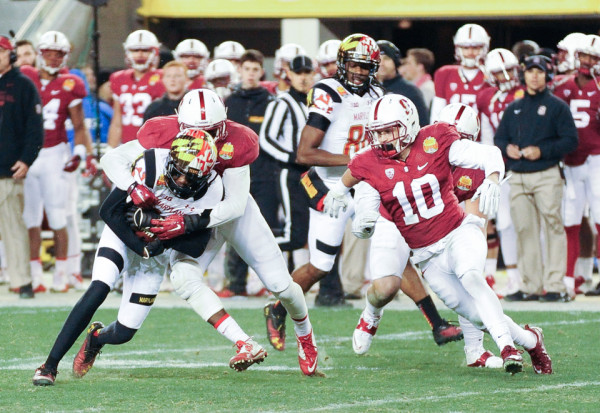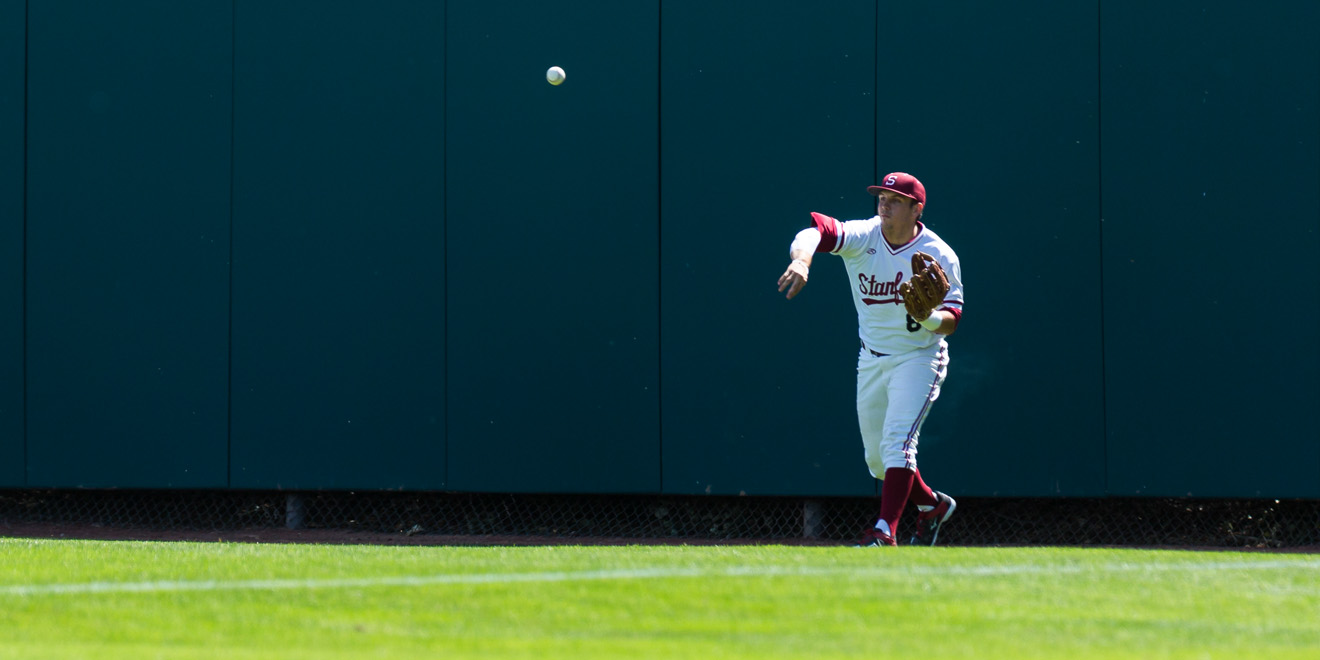It’s impossible to ignore the decorated history of baseball-football two-sport athletes at Stanford when the names atop the list are as distinguished as John Elway, John Lynch, Toby Gerhart and Tyler Gaffney.
What do those four Cardinal legends have in common? All four went from being Stanford stars to playing in the NFL — choosing professional football over careers in baseball.
It’s time to add Zach Hoffpauir to that list — but it looks like he’s going to be the exception to the rule, and come this June’s MLB Draft, he’ll look to become one of few Stanford two-sport stars to select baseball over football.
“I’d say that if I wanted to play pro baseball, this would be the year to do it,” Hoffpauir said. “I’m very solid — I’m 100 percent signable, and I want to sign this year. If I get what I want, then I’ll go.”
Gaffney, of course, also initially chose baseball and played in the Pittsburgh Pirates’ farm system for a year before getting the football itch and returning for a Rose Bowl senior season at Stanford. Now he’s got a Super Bowl ring with the New England Patriots.
But for Hoffpauir, playing professional baseball is a dream that he has had all his life — he didn’t even start playing football until high school — and if he leaves in this year’s MLB Draft, he knows that it’s a decision he’s going to make for good.
“I think Tyler had his own plan of what he wanted to do, and it worked out great for him,” Hoffpauir said. “He was playing well when he was playing baseball, and now he’s getting money playing football and won a Super Bowl.
“With me, my decision’s a little bit different, and I think the one I pick is the one I’m going to stay with. I’m not going to leave, go play pro baseball and come back as like a fifth-year.”
He has balanced many factors, including the health-related concerns of pursuing an NFL career, which became even more of a consideration after he suffered a concussion this last season during a game against Oregon State, for which he had to sit out the Oregon game while undergoing the proper evaluations.
“My first [concussion], and it opened my eyes to that a little bit,” he said. “Obviously I love football. Football is a ton of fun, but you have a very short career.”
It’s not just a concussion issue, though — Hoffpauir pointed to Gaffney’s training-camp knee injury as a specific example of the frequent joint and ligament injuries that occur much more often in football than they do in baseball. From a monetary and a career perspective, Hoffpauir believes that baseball is the safer investment.
“The longevity aspect in baseball is there, and I’m thinking that my life after football is a lot more important and it’s longer than my lifetime playing football. That’s a big decision as well,” he said.
Of course, Stanford football would love to have Hoffpauir back for his senior season this coming fall given how Hoffpauir’s departure would be yet another in a series of big losses including Alex Carter, Wayne Lyons, Jordan Richards and Kyle Olugbode. But through the process, Stanford’s coaching staff has been nothing but supportive of Hoffpauir’s personal plans and goals.

He plans to chat with strength and conditioning coach Shannon Turley, and he’s already had a talk with his position coach, Duane Akina. Hoffpauir also had a long chat with head coach David Shaw about his decision during Stanford’s big visit weekend from recruits this year. And through it all, Shaw’s message has been the same.
“He said, ‘You know, if you get what you want, then don’t think about it. Just do it. If you don’t, then come back and play. It’s pretty simple,’” Hoffpauir recounted. “He’s not persuading me in any way. He just gave me his advice and let me make my decision.”
And the decision seems to be all but made for Hoffpauir at this stage — that is, assuming that the price is right.
***
The only factor that would keep Hoffpauir from signing with a team that would draft him this summer would be if the signing bonus from his eventual deal isn’t enough to entice him to leave Stanford, as was the case for Mark Appel in the 2012 MLB Draft, when Appel couldn’t come to an agreement with the Pittsburgh Pirates after being selected No. 8 overall.
“I’ve figured out what amount of money I’ll go for,” Hoffpauir said. “The round does matter to an extent, but at the same time, I want a good amount of money.”
Negotiating signing bonuses in the aftermath of an MLB Draft is a notoriously fickle art. Over the first 10 rounds of any MLB Draft, each selection has a “slot value” depending on where he’s taken, which is where negotiations start between the player and the team for a signing bonus. Each team has a hard limit on the amount of money it can use on total signing bonuses over the first 10 rounds — after that, anything goes. However, only the top 10 rounds are really relevant to Hoffpauir, who figures to be drafted in that range.
Those “slot values” range from $8.6 million with the first overall pick for the Arizona Diamondbacks all the way down to $149,700 with the 315th overall pick, which is the final selection of the 10th round. However, because a lot of teams need to commit more money to their upper-round selections to ensure that they sign, selections in the later rounds will often see their signing bonuses severely undercut so that teams don’t go over their caps.
A good example of this for Stanford was last season, when Danny Diekroeger got selected with the final pick of the 10th round by the Cardinals and signed for a paltry $5,000 despite the slot value for his pick being listed as $137,600. Diekroeger didn’t really have a choice — as a senior, he was out of options.
However, Hoffpauir has a lot of elements that play to his advantage in a negotiation situation.
For one, he’s still a junior, meaning that if he doesn’t get a signing bonus that he likes, he can just come back for his senior season and play both football and baseball one more time, likely improving his draft stock in both sports in the process and potentially taking his services elsewhere.
The two-sport element also helps. Given that Hoffpauir also forecasts well into the NFL as a safety and nickelback, he can use his football talent as significant leverage in negotiations.
“With football, I always knew I could play in the NFL, but my career’s been different from what I thought it would be,” Hoffpauir said. “But I’m in a good spot now if I wanted to play professional football.”
A tough negotiation assumes that Hoffpauir is drafted late in the first 10 rounds, which given his production, isn’t a safe assumption to make. Hoffpauir has always been a strong hitter — he broke out in a big way last year with a .324/.379/.507 triple slash, 7 home runs and 35 RBIs — and has battled through injury this year to lead the team in home runs and continue to provide solid middle-of-the-order production at the plate.
He also believes that teams will recognize that his ceiling is a lot higher than those of most other players in the draft, because unlike the other guys that play in summer leagues and practice their baseball techniques during the offseasons, he has to completely switch gears and ignore baseball for half the year.
“I think this is what intrigues a lot of teams — that I’m able to put up good numbers now and I only play baseball four months out of the year,” he said. “I get back in the winter about a month before [baseball] season, and I have a month to try to get caught up to perform as a middle-of-the-lineup guy in the Pac-12.”
Given his solid numbers and his strong leverage in negotiations, things are all going according to plan for Hoffpauir. Now, it’s just a matter of approaching the draft and fine-tuning his expectations given draft projections and communications from teams.
“This has been my plan all along — get to junior year, draft comes, and see where I go in the baseball draft,” he said. “If I go where I want, I’m leaving. If I don’t, I’ll stay. That really hasn’t changed.”
***
When reflecting on his Stanford career, Hoffpauir describes the life of a two-sport athlete as “a lonely lifestyle.”
When the football guys go to San Francisco on weekends during winter and spring quarters, Hoffpauir is busy at Sunken Diamond taking batting practice and playing baseball games. Meanwhile, when his baseball teammates are tailgating or going to games in the fall, he’s busy working his backside off for the football team.
And to add on, because of the unique nature of his year-round preparation, he doesn’t lift with either his baseball or football teammates — he lifts and conditions by himself.
“You’re never with the same group of people,” he said. “You’re alone a lot.”
But Hoffpauir has certainly been okay with that lifestyle, and outside of the close friendships that he has developed with Jordan Richards and Ronnie Harris, along with his two-year roommate, Dontonio Jordan, he’s “always been the kind of person to bounce around between friends anyway.”
And from an athletic standpoint, having been a two-sport athlete has not only just given him the obvious advantage of leaving his mark on two programs, but it has also offered him the flexibility and leverage in this scenario that he has always wanted.
“If I focused on one, could I be better at it and be in a better spot? Maybe,” he said. “But I don’t regret anything. I’m very happy with where I’m at right now.”
Of course, it also doesn’t hurt that the title of “football-baseball athlete” allows him to join the ranks of decorated sportsmen like Elway, Nevers, Gerhart, Gaffney, Mark Marquess, Chad Hutchinson and others that paved the way before him.
And through his achievements at both Stanford Stadium and Sunken Diamond, he has certainly lived up to those predecessors on the Farm. Now, he has an opportunity to be one of the first to take those two-sport skills into the MLB and not the NFL.
“I’m glad I played two sports, just because I’m the type of person where I want to be unique,” he said. “I want to be different. Not too many people have played two sports at the level I’ve played them at.”
Contact Do-Hyoung Park at dhpark ‘at’ stanford.edu.
